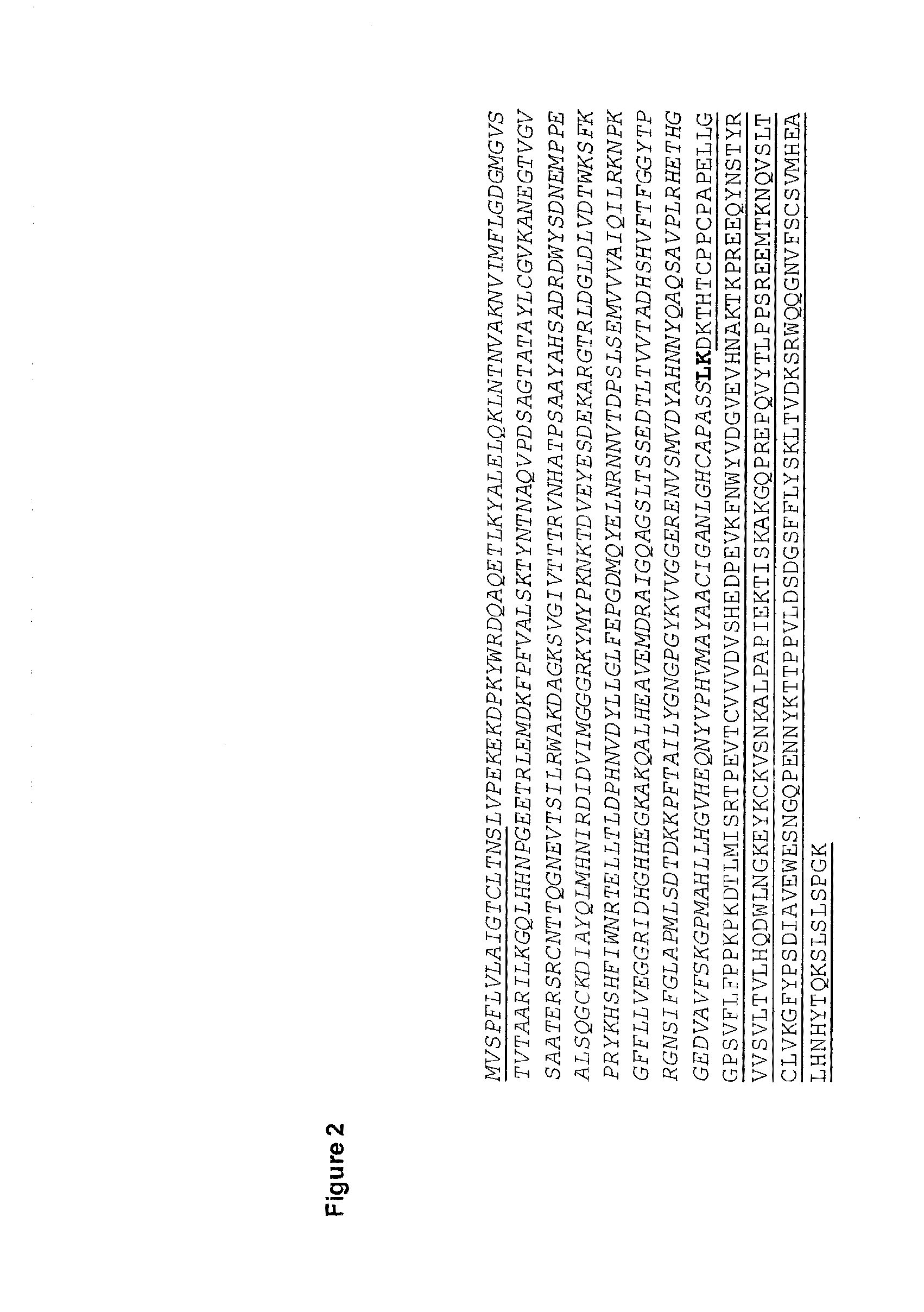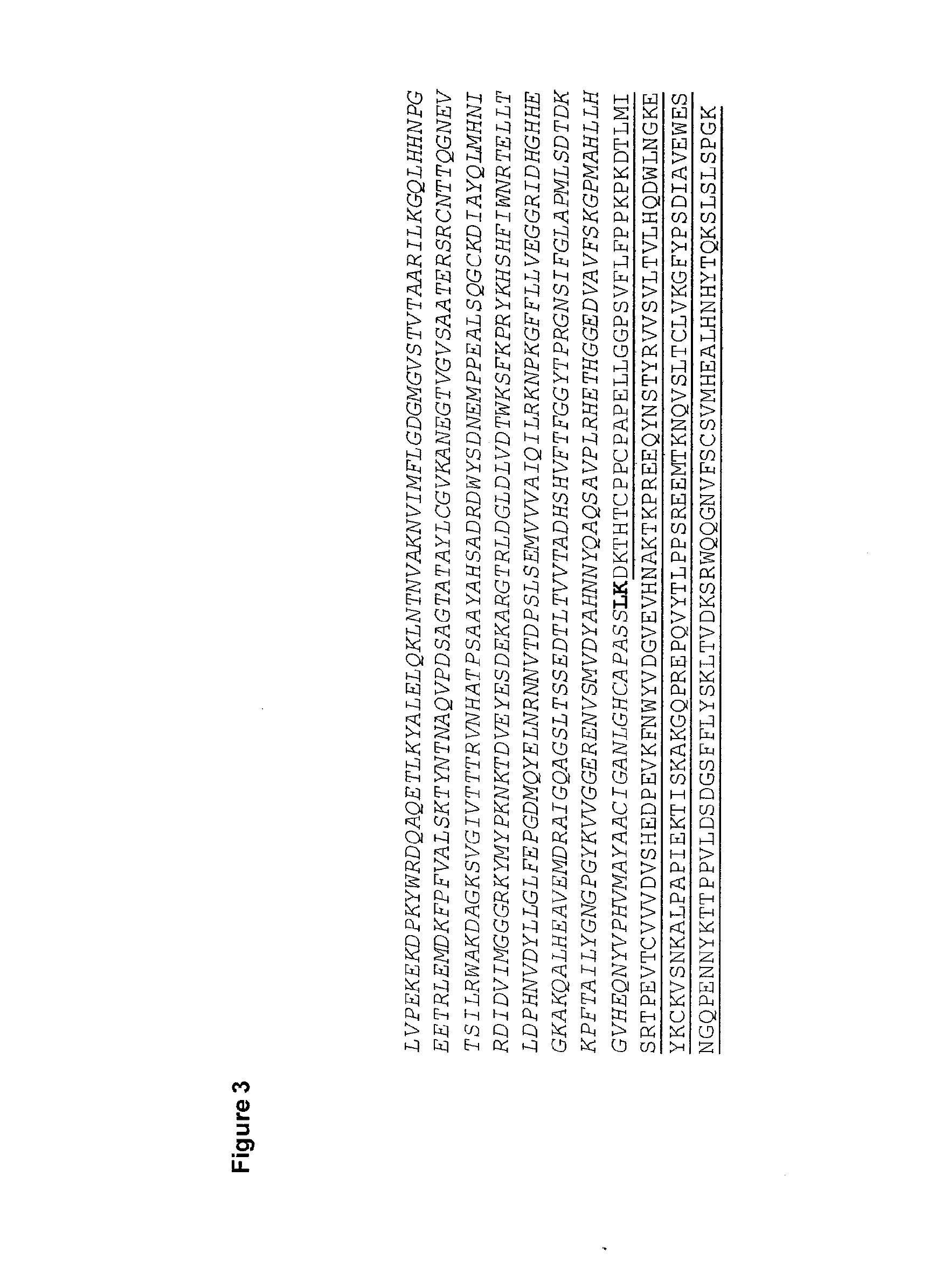Methods, compositions, and kits for the treatment of matrix mineralization disorders
a matrix mineralization and disorder technology, applied in the field of matrix mineralization disorders, can solve the problems of impaired skeletal mineralization, rickets or osteomalacia, and almost complete absence of bon
- Summary
- Abstract
- Description
- Claims
- Application Information
AI Technical Summary
Benefits of technology
Problems solved by technology
Method used
Image
Examples
example 1
Expression and Production of sALP-Fc
[0105]sALP-Fc cDNA was generated by PCR amplification from pIRES-sALP-FcD10 plasmid, and cloned into the pSV (Hygromycin) expression vector (Selexis Inc.). CHO-K1 S cells grown in Power CHO2 CD media (Lonza) supplemented with 4 mM L-glutamine (Wisent) were transfected with PvuI-linearized pSV-sALP-Fc plasmid using the manufacturer's protocol. Forty-eight hours after transfection, media was replaced with media containing 200 μg / mL hygromycin B (Invitrogen). Viability was monitored and media was replaced every 96 hours. Once viability attained 90%, culture was screened for high expression clones using Clonepix FL technology platform (Genetix Inc.) using a FITC-coupled anti-sALP antibody. Best clones were amplified and selected in 96-well plates using sALP enzymatic assay on culture supernatant. Selected clones were amplified and grown in 25 L WAVE bioreactor. At the end of the culture, the concentration of sALP-Fc in the spent medium was 135 mg / L as...
example 2
Papain digestion to generate sALP
[0106]sALP was generated from sALP-Fc using papain digestion as follows: sALP-Fc was first dialyzed against Digestion buffer (20 mM sodium phosphate, pH 7.0) using Vivaspin units (Sartorius VS2022), adjusted to 10 mg / mL, and added to Eppendorf tubes at 600 μL per tube. In parallel, papain-agarose (Sigma P4406) was resuspended in Wash buffer (20 mM sodium phosphate, 1 mM EDTA, pH 6.9) at 25 units in 1.5 mL. To digest 1 nmol of sALPFc, 42 mU of papain-agarose was transferred to a conical tube, centrifuged for 5 min at 1000 g and washed with 10 volumes of Digestion buffer. After another spin down, the beads were resuspended in Digestion buffer and adjusted to the same total volume as prepared sALPFc. Papain was then activated by adding 10 mM DTT to have a final concentration of 0.5 mM. 600 μL of papain-agarose was then immediately added to each Eppendorf containing sALPFc which was pre-heated at 37° C., and incubated for 2 hours at 37° C. with mild agit...
example 3
Pharmacokinetic Analysis of sALP and sALP-Fc
[0107]In vivo pharmacokinetic (PK) studies were performed on purified sALP and sALP-Fc, which were administered intravenously (IV) and subcutaneously (SC) to 5-6 week old C57BL / 6 male mice.
Experimental Design
[0108]Animals received a single IV or SC dose as described in Table 1.
TABLE 1Experimental design of an in vivo PK study of sALP andsALP-Fc in miceGroupGroupDose LevelAnimals No.No.Description(U / kg)PK Time pointsMales1sALP100000.5, 4 and 26 hr101, 102, 103IVpost dose1, 8 and 32 hr104, 105, 106post dose2, 12 and 49 hr107, 108, 109post dose21 and 45 hr110, 111, 112post dose2sALP100004, 6 and 26 hr201, 202, 203SCpost dose1, 8 and 32 hr204, 205, 206post dose2, 12 and 49 hr207, 208, 209post dose21 and 45 hr210, 211, 212post dose3sALP-Fc20000.5, 26 and 96 hr101, 102, 103IVpost dose1, 8 and 49 hr104, 105, 106post dose3, 12 and 32 hr107, 108, 109post dose21, 45 and 72 hr110, 111, 112post dose4sALP-Fc20006, 26 and 96 hr201, 202, 203SCpost dose1,...
PUM
| Property | Measurement | Unit |
|---|---|---|
| concentration | aaaaa | aaaaa |
| concentration | aaaaa | aaaaa |
| concentration | aaaaa | aaaaa |
Abstract
Description
Claims
Application Information
 Login to View More
Login to View More - R&D
- Intellectual Property
- Life Sciences
- Materials
- Tech Scout
- Unparalleled Data Quality
- Higher Quality Content
- 60% Fewer Hallucinations
Browse by: Latest US Patents, China's latest patents, Technical Efficacy Thesaurus, Application Domain, Technology Topic, Popular Technical Reports.
© 2025 PatSnap. All rights reserved.Legal|Privacy policy|Modern Slavery Act Transparency Statement|Sitemap|About US| Contact US: help@patsnap.com



